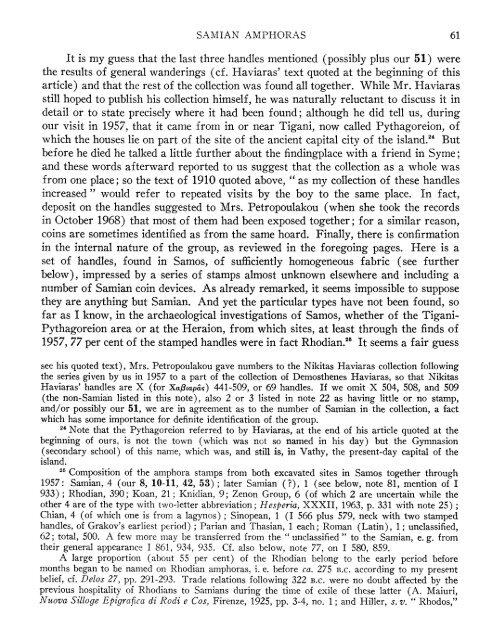SAMIAN AMPHORAS - The American School of Classical Studies at ...
SAMIAN AMPHORAS - The American School of Classical Studies at ...
SAMIAN AMPHORAS - The American School of Classical Studies at ...
Create successful ePaper yourself
Turn your PDF publications into a flip-book with our unique Google optimized e-Paper software.
<strong>SAMIAN</strong> <strong>AMPHORAS</strong> 61<br />
It is my guess th<strong>at</strong> the last three handles mentioned (possibly plus our 51) were<br />
the results <strong>of</strong> general wanderings (cf. Haviaras' text quoted <strong>at</strong> the beginning <strong>of</strong> this<br />
article) and th<strong>at</strong> the rest <strong>of</strong> the collection was found all together. While Mr. Haviaras<br />
still hoped to publish his collection himself, he was n<strong>at</strong>urally reluctant to discuss it in<br />
detail or to st<strong>at</strong>e precisely where it had been found; although he did tell us, during<br />
our visit in 1957, th<strong>at</strong> it came from in or near Tigani, now called Pythagoreion, <strong>of</strong><br />
which the houses lie on part <strong>of</strong> the site <strong>of</strong> the ancient capital city <strong>of</strong> the island.24 But<br />
before he died he talked a little further about the findingplace with a friend in Syme;<br />
and these words afterward reported to us suggest th<strong>at</strong> the collection as a whole was<br />
from one place; so the text <strong>of</strong> 1910 quoted above, " as my collection <strong>of</strong> these handles<br />
increased" would refer to repe<strong>at</strong>ed visits by the boy to the same place. In fact,<br />
deposit on the handles suggested to Mrs. Petropoulakou (when she took the records<br />
in October 1968) th<strong>at</strong> most <strong>of</strong> them had been exposed together; for a similar reason,<br />
coins are sometimes identified as from the same hoard. Finally, there is confirm<strong>at</strong>ion<br />
in the internal n<strong>at</strong>ure <strong>of</strong> the group, as reviewed in the foregoing pages. Here is a<br />
set <strong>of</strong> handles, found in Samos, <strong>of</strong> sufficiently homogeneous fabric (see further<br />
below), impressed by a series <strong>of</strong> stamps almost unknown elsewhere and including a<br />
number <strong>of</strong> Samian coin devices. As already remarked, it seems impossible to suppose<br />
they are anything but Samian. And yet the particular types have not been found, so<br />
far as I know, in the archaeological investig<strong>at</strong>ions <strong>of</strong> Samos, whether <strong>of</strong> the Tigani-<br />
Pythagoreion area or <strong>at</strong> the Heraion, from which sites, <strong>at</strong> least through the finds <strong>of</strong><br />
1957, 77 per cent <strong>of</strong> the stamped handles were in fact Rhodian.2" It seems a fair guess<br />
see his quoted text), Mrs. Petropoulakou gave numbers to the Nikitas Haviaras collection following<br />
the series given by us in 1957 to a part <strong>of</strong> the collection <strong>of</strong> Demosthenes Haviaras, so th<strong>at</strong> Nikitas<br />
Haviaras' handles are X (for Xafltapals) 441-509, or 69 handles. If we omit X 504, 508, and 509<br />
(the non-Samian listed in this note), also 2 or 3 listed in note 22 as having little or no stamp,<br />
and/or possibly our 51, we are in agreement as to the number <strong>of</strong> Samian in the collection, a fact<br />
which has some importance for definite identific<strong>at</strong>ion <strong>of</strong> the group.<br />
24 Note th<strong>at</strong> the Pythagoreion referred to by Haviaras, <strong>at</strong> the end <strong>of</strong> his article quoted <strong>at</strong> the<br />
beginning <strong>of</strong> ours, is not the town (which was not so named in his day) but the Gymnasion<br />
(secondary school) <strong>of</strong> this name, which was, and still is, in V<strong>at</strong>hy, the present-day capital <strong>of</strong> the<br />
island.<br />
25 Composition <strong>of</strong> the amphora stamps from both excav<strong>at</strong>ed sites in Samos together through<br />
1957: Samian, 4 (our 8, 10-11, 42, 53); l<strong>at</strong>er Samian (?), 1 (see below, note 81, mention <strong>of</strong> I<br />
933); Rhodian, 390; Koan, 21; Knidian, 9; Zenon Group, 6 (<strong>of</strong> which 2 are uncertain while the<br />
other 4 are <strong>of</strong> the type with two-letter abbrevi<strong>at</strong>ion; Hesperia, XXXII, 1963, p. 331 with note 25);<br />
Chian, 4 (<strong>of</strong> which one is from a lagynos); Sinopean, 1 (I 566 plus 579, neck with two stamped<br />
handles, <strong>of</strong> Grakov's earliest period); Parian and Thasian, 1 each; Roman (L<strong>at</strong>in), 1; unclassified,<br />
62; total, 500. A few more may be transferred from the " unclassified " to the Samian, e. g. from<br />
their general appearance I 861, 934, 935. Cf. also below, note 77, on 1 580, 859.<br />
A large proportion (about 55 per cent) <strong>of</strong> the Rhodian belong to the early period before<br />
months began to be named on Rhodian amphoras, i. e. before ca. 275 B.C. according to my present<br />
belief, cf. Delos 27, pp. 291-293. Trade rel<strong>at</strong>ions following 322 B.C. were no doubt affected by the<br />
previous hospitality <strong>of</strong> Rhodians to Samians during the time <strong>of</strong> exile <strong>of</strong> these l<strong>at</strong>ter (A. Maiuri,<br />
Nuova Silloge Epigrafica di Rodi e Cos, Firenze, 1925, pp. 3-4, no. 1; and Hiller, s. v. " Rhodos,"

















